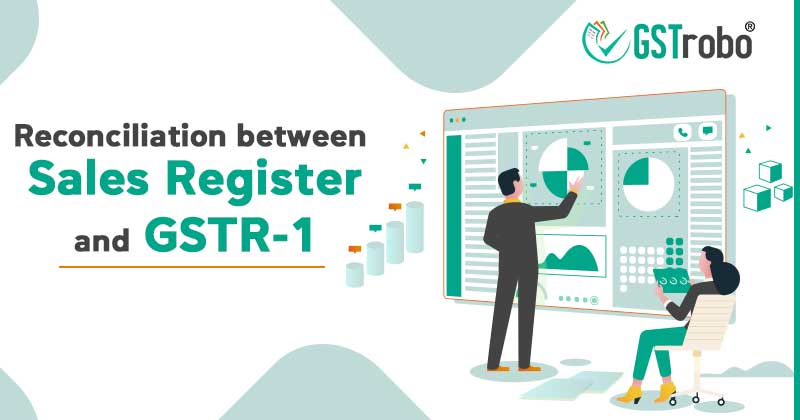Reconciliation between Sales Register and GSTR-1
Every person who is registered as a normal taxable person under GST needs to file GSTR-1 monthly or quarterly. And, any error in it can lead to penalties and interest. Hence, you must reconcile the sales register and GSTR-1.

- What are Sales Register and GSTR-1?
- Importance of Reconciliation between Sales Register and GSTR-1
- Reasons for Mismatches between Sales Register and GSTR-1
- How to Reconcile Mismatches between Sales Register and GSTR-1?
- Process to Reconcile Sales Register and GSTR-1
- Consequences of Not Reconciling Sales Register and GSTR-1
What are Sales Register and GSTR-1?
A sales register shows the data of the sales made by a business concern during a period. The sales register generally consists of details about the sales with recipient name, invoice date (chronological order), invoice value, place of supply, and so forth.
GSTR-1 is a monthly or quarterly GST return that consists of outward supplies including tax liability. GSTR-1 includes invoice level data that helps the Government to keep track of every transaction.
Importance of Reconciliation between Sales Register and GSTR-1
As we already know that GSTR-1 consists of data of outward supply (sales) during a particular period and sales registers include all the information related to sales. So, reconciliation between GSTR-1 and the sales register will help you to verify details of outward supplies between the two. And in case of any discrepancy, it will help you amend GSTR-1. Moreover, reconciliation between GSTR-1 and sales Register is also extremely useful for finalizing the Sales Register at the end of the financial year and filing of GSTR-9.
Reasons for Mismatches between Sales Register and GSTR-1
There are varied reasons for mismatches between the sales register and GSTR-1:
- You forget to record the transaction in the sales register in the period in which occurred.
- You recorded the sales transaction in the current taxable period but furnished the GSTR-1 containing the same in the subsequent taxable period.
- Incorrect data filings such as GSTIN, tax values, invoice dates, place of supply, etc either in the GSTR-1 or sales register
How to Reconcile Mismatches between Sales Register and GSTR-1?
There are two ways using which you can easily reconcile mismatches between sales register and GSTR-1:
- If you find any mismatch between the sales register and GSTR-1 you can amend it in the subsequent month or quarter GSTR-1.
- In case if you fail to amend it in the GSTR-1, you can do the final settlement in the Annual GST return for short payment of taxes.
However, it shall be noted that you cannot claim a refund for excess tax paid.
Process to Reconcile Sales Register and GSTR-1
You can reconcile the sales register and GSTR-1 either manually or through software.
Manual Reconciliation Process
- You need to first download the GSTR-1 from the GST portal.
- Afterward, you need to enter the sales register and GSTR-1 data in excel to match it using look-up and pivot tables.
- Once you are done with the reconciliation, you need to amend all the mismatches or errors.
However, the number of outward supplies depends on the nature of business and it can vary from a few to thousands or even more. And depending on the data reconciling GSTIN, tax values, invoice dates, place of supply, etc will take a considerable amount of time.
Reconciliation using Software
Although this reconciliation can be avoided altogether if your sales register is pushed to software via API from your accounting package or ERP, the chances of mismatches will be negligible. Even with the slightest of chances if an error occurs an auto-generated report can provide a warning before you proceed to file your GSTR-1 or GSTR-9.
Consequences of Not Reconciling Sales Register and GSTR-1
In case if the GST officers find any mismatch between your sales register and GSTR-1 or GSTR-9, you may get scrutinize for the same. Even you may get penalized along with interest for the short payment of tax.
